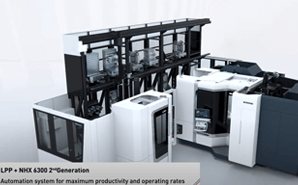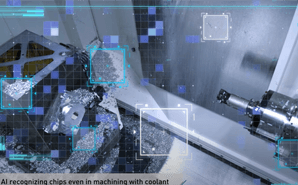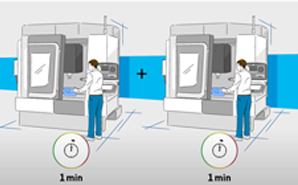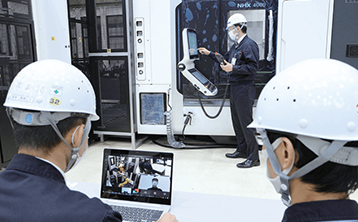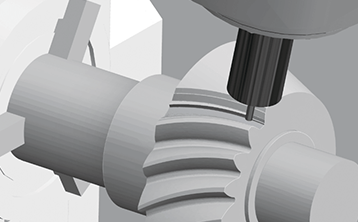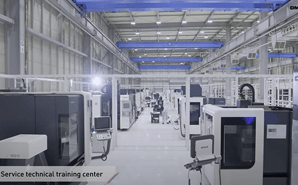Product Initiatives
Social issues
The population of production workers is decreasing with the aging of society, and manufacturing sites are now facing personnel shortage issues, such as problems retaining sufficient numbers of expert machining technicians. At the same time, there is a growing demand for production systems that do not rely on human resources, improving the energy efficiency of machine tools, and improving working environments.
DMG MORI initiatives
We continue to promote automation in order to efficiently produce products with few operators, and are researching and developing machine tool element technologies in order to ensure that production is sustainable and has a low burden on the environment.
Initiative 1: GREENmode
DMG MORI products are equipped with GREENmode functionality, which reduces power consumption 45% compared with products we manufactured in 1997. We take the machining applications and mechanical characteristic of each product into consideration when programming so that machining uses less power and is more efficient. We take four perspectives into consideration when doing so: machining time reduction, visualization, optimization, and new functionality. DMG MORI is unique in that our products include nine functions to make machining more efficient and reduce machining time. By optimizing our machining methods, we not only help improve customer productivity, but can also contribute toward reducing power consumption and realizing sustainable societies from an environmental conservation perspective.
Energy efficiency is optimized during machine operation, reducing CO2 emissions.
Machines and tools are used to their maximum potential, improving machining conditions and reducing machining time
Power to parts such as the main drive, chip conveyor, and coolant pump is shut off when the machine is stopped, reducing power consumption during standby when no power is needed
Visualization of power consumption and CO2 emissions
*The results described above may not be achieved, depending on differences in machine or cutting conditions and on environmental conditions during measurement.

DMG MORI will contribute to advance the further development of highly innovative components for green technologies such as parts for fuel cells or electric mobility.
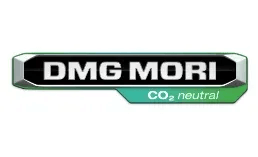
DMG MORI provides products which are carbon-neutrally produced for the entire manufacturing value chain; including own business activities and parts procurement across the world.
Starting from January 2021, all our machines which are carbon-neutrally produced have been shipped around the world with the “GREENMACHINE” mark.
Initiative 2: Automation
Although we continue to develop automated systems for exchanging workpieces and transferring pallets, simply automating workpiece and pallet exchange is not enough to keep automation systems working reliably. By enabling machines to do the kind of work traditionally done by an operator (measurement, monitoring, and cleaning), we will realize the first machining line that operates at the same level as a manned line. Toward that end, we continue to actively develop the element technologies required to use automation to achieve reliable unmanned operation and operation using few operators. Some examples of the functions we provide include a contactless machine measuring instrument for measuring parts with complex shapes at high speed, Tool Profiler to measure tool shapes and detect chips wrapped around tools, AI chip removal to detect and wash away chips accumulated inside machines, and DMG MORI Messenger to remotely monitor machine operation.
Initiative 3: Cleaner chips, coolant, and mist
Chip disposal, cutting fluid maintenance management, and measures to prevent mist in machines are all important topics with an impact on machining. For example, phenomena such as chips accumulating in a machine and wrapping around a tool, or operator mistakes such as mistakenly using deteriorated cutting fluid or filling a machine with cutting fluid that has vaporized and then leaks outside the machine will cause machine stoppages and reduce productivity. It could even impact operator health. DMG MORI has launched an organization dedicated to finding chip, coolant, and mist solutions, and we continue to research and develop in order to make factories cleaner and safer for all workers.
Initiative 4: Process aggregation and improved machining time through use of 5-axis/multi-axis machines
Advances in machine tool technology have made it possible to use a single 5-axis/multi-axis machine to perform processes that traditionally have been split up among multiple machines. All processes can be completed with a single chucking operation and setup work can be reduced, which can make it easier to introduce automation. Aggregating processes on a single machine can also help reduce the number of machines and the amount of energy that is consumed. Further improvements can be made by incorporating processes that were once done by specialized machines (such as turning, milling, grinding, additive manufacturing (AM), and measuring) into a 5-axis/multi-axis machine.
Initiative 5: Use of digital technologies
We continue our efforts to apply digital technologies toward accelerating work that has traditionally been done in-person and on-site, such as in-person observation machining, test machining, and repair/restoration work. For example, during in-person observation machining, a customer will visit a DMG MORI plant for a final confirmation, which involves checking machining accuracy and machine operation. However, we can use an online conferencing system to hold digital in-person observation machining for the benefit of customers inside or outside Japan who cannot easily make it to one of our plants. We have also started using digital twin technology for digital twin test cutting for test machining. We can use a computer to analyze machining loads, machining vibration, and machining times, and then can run quick simulations under optimal machining conditions. This means that we can use a computer to arrive at the ideal machining solution instead of having to prepare tools, jigs, and materials to repeatedly perform and verify actual machining, which has made it possible to reduce time spent on test machining. For repair and restoration work, we continue to develop functionality that will allow the DMG MORI Service Center to monitor customer machine alarms to prevent machine stoppages from occurring, and to have a Service Center operator diagnose any problems that might occur online, in order to restore products faster. Machine tools are consumables that are used for a long time. We are working toward applying digital technologies toward managing electronic components and other parts in order to more smoothly repair and restore products, ensuring that they can continue be used reliably for a long time.

